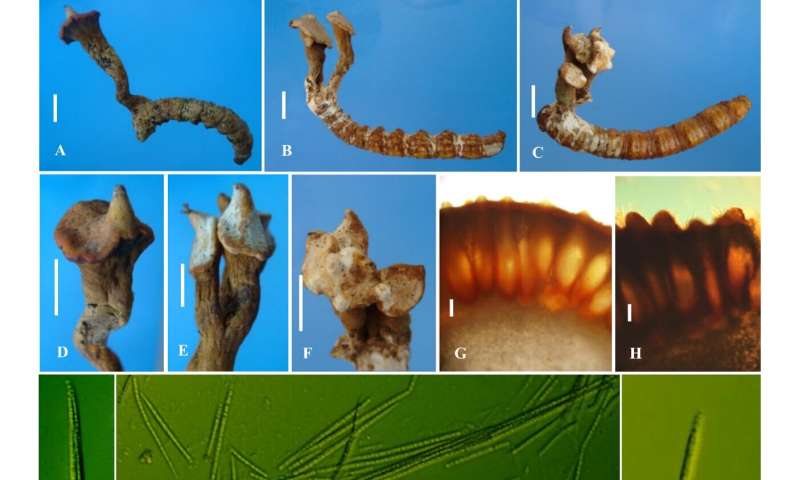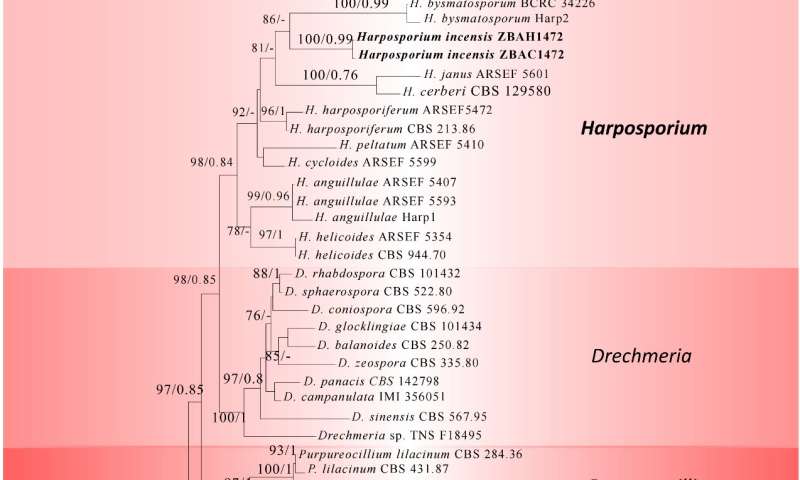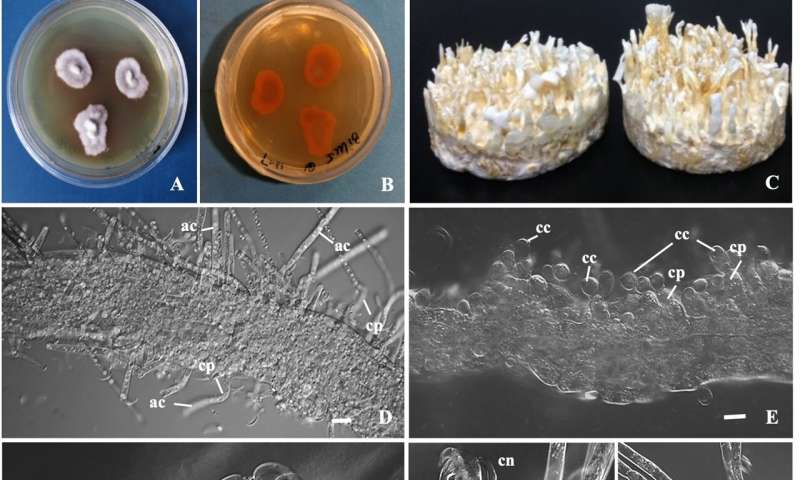Study identifies new specifies of cordycipitoid fungi

The genus of Harposporium belongs to the Ascomycota of the Fungi kingdom, the class Sortariomycetes, the order Hypocreales, and the family Ophiocordyceiaceae, and is a common genus of soil fungi. The species of Harposporium are pathogens of nematodes, with some also infecting rotifers or tardigrades, and has significant ecological value.
In recent years, studies have shown that a few species of the genus Harposporium can also parasitize insects or other invertebrates, such as H. janus, which can infect beetles in the Coleoptera family. However, so far, it has not been found that the same species in this genus can parasitize different invertebrates in both sexual and asexual stages.
Is there a sexual and asexual stage of species in the genus Harposporium that can infect insects and nematodes, respectively? These two types of invertebrates have different ecological niches, including microhabitats, trophic modes, ecological adaptation, behavior, as well as epizootiology. Further research is needed on how pathogenic fungi achieve host jumping.
Isolation and cultivation of cordycipitoid fungi were collected from a pigeon pea plantation in Huánuco Province, Peru, and combined with five fragments of ITS-SSU-LSU-EF-1α-RPB1-RPB2 to construct a phylogenetic tree of the genus Harposporium and related genera.
The analysis results show that the Ophiocordyceiaceae is composed of five main lineages (Clade Harposporium, Clade Drechmeria, Clade Purpureocillium, Clade Ophiocordyceps and Clade Tolypocladium), with sexual and asexual strains of H. incensis clustered into one lineage, all of which have high support rates (MLBS=99.2%, BIPP=1.00), supporting them as a new group within the Harposporium genus, and are associated with H. bysmatosporum, H. janus, H. cerberi, H. cyclides, and H. harposporiferum forms a phylogenetic sister species.
This study was based on morphological observation and molecular systematics analysis to explore the sexual and asexual characteristics of the cordycipitoid fungi specimen. It was identified as a new species of the genus Harposporium and based on the mitochondrial Cox1 gene sequence, its host was accurately identified as the Lepidoptera insect Trichophassus giganteus.
Research has found that this asexual strain can infect Caenorhabditis elegans and can produce many falciform conidia. The article also provides identification characteristics of the new species that are different from those of similar species in this genus.
-

Phylogenetic relationships among Harposporium and related genera using ITS, SSU, LSU, EF-1α, RPB1 and RPB2 sequences. Credit: Zengzhi Li, Provincial Key Laboratory of Microbial Control, Anhui Agricultural University; Zhejiang BioAsia Pharmaceutical Institute -

Taxonomic characteristics of asexual strains of Harposporium incensis. Credit: Zengzhi Li, Provincial Key Laboratory of Microbial Control, Anhui Agricultural University; Zhejiang BioAsia Pharmaceutical Institute
Based on systematic and morphological studies, this study identified a new species of cordycipitoid fungi collected from pigeon pea plantation in Huánuco Province, Peru, which named Harposporium incensis. It has found that its sexual stage parasitizes Lepidoptera insects, while asexual stage can infect nematodes and produce a large number of falciform conidia.
The article discusses in detail the possible reasons and survival strategies for the host jumping of this strain with different life types, and looks forward to its potential as a biological control agent against Trichophassus giganteus and important biological pathogens of agricultural and forestry root diseases—nematodes.
The paper is published in the journal Mycology.
More information:
Ming-Jun Chen et al, Harposporium incensis sp. nov. a South American cordycipitoid species exhibiting inter-phylum host-jumping and having potential as a biological control agent for pest management, Mycology (2024). DOI: 10.1080/21501203.2024.2350959
Provided by Tsinghua University Press